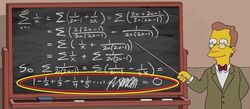Log 2 equals to 0
 Consider the harmonic series:
x
=
1
∑
∞
x
1
=
1
1
+
2
1
+
3
1
+
4
1
+
5
1
+
…
Consider the harmonic series:
x
=
1
∑
∞
x
1
=
1
1
+
2
1
+
3
1
+
4
1
+
5
1
+
…
I'm going to rearrange the terms to obtain ln ( 2 ) = 0 by first grouping the terms in pairs:
x = 1 ∑ ∞ x 1 x = 1 ∑ ∞ x 1 0 0 0 = = = = = = = = = = ( 1 1 + 2 1 ) + ( 3 1 + 4 1 ) + ( 5 1 + 6 1 ) + … x = 1 ∑ ∞ ( 2 x − 1 1 + 2 x 1 ) x = 1 ∑ ∞ ( 2 x ( 2 x − 1 ) 2 x + 2 x − 1 ) x = 1 ∑ ∞ ( 2 x ( 2 x − 1 ) 2 ( 2 x − 1 ) + 1 ) x = 1 ∑ ∞ [ 2 x ( 2 x − 1 ) 2 ( 2 x − 1 ) + 2 x ( 2 x − 1 ) 1 ] x = 1 ∑ ∞ [ x 1 + 2 x ( 2 x − 1 ) 1 ] x = 1 ∑ ∞ x 1 + x = 1 ∑ ∞ 2 x ( 2 x − 1 ) 1 x = 1 ∑ ∞ 2 x ( 2 x − 1 ) 1 x = 1 ∑ ∞ ( 2 x 1 − 2 x − 1 1 ) 1 − 2 1 + 3 1 − 4 1 + 5 1 − … = ln ( 2 )
Above shows 10 steps for the supposed claim of ln ( 2 ) = 0 . How many of these steps are incorrect?
Adapted from Simon Singh's blog .
Scene is at 6 minute 46 seconds of the episode Sky Police from The Simpsons.
No copyright infringement intended.
This section requires Javascript.
You are seeing this because something didn't load right. We suggest you, (a) try
refreshing the page, (b) enabling javascript if it is disabled on your browser and,
finally, (c)
loading the
non-javascript version of this page
. We're sorry about the hassle.
Apparently the Simpsons did a flawed proof of how ln 2 = 0 independently of my own flawed proof. Oh well.
As Simon Singh's blog says, you cannot simply cancel infinities on both sides. This is perhaps related to the Riemann series theorem .
Also, the ninth step's partial fraction decomposition is very silly. And wrong.